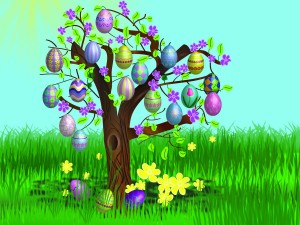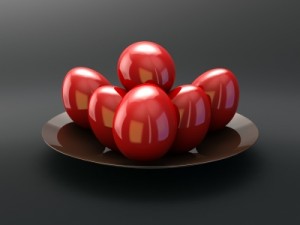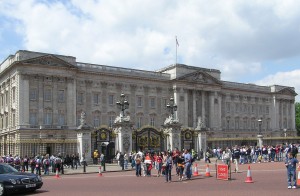 Easter and Christmas are the two most important Christian holidays. With Easter Sunday coming in 3 days, I thought it would be a nice idea to see some of the Easter traditions and customs around the world, along with some facts. Did you know that many aspects of the celebrations pre-date Christianity with some of them having ancient roots?
Easter and Christmas are the two most important Christian holidays. With Easter Sunday coming in 3 days, I thought it would be a nice idea to see some of the Easter traditions and customs around the world, along with some facts. Did you know that many aspects of the celebrations pre-date Christianity with some of them having ancient roots?
.
.
Easter Facts
Date Calculation
First things first, Easter is a moveable feast and the number 1 question I’ve had since my childhood is “how on earth do we know on which date Easter falls each year? Who decides it?” -well, back then everything I couldn’t understand had to be a “grown-up decision”. You’d be surprised, but I didn’t get my answer until recently. I found out how this date is calculated last year, while searching for a particular name day.
Do you know the answer? The truth is, it is very simple actually.
Easter Sunday can only fall between the dates of 22nd March and 25th April and it is based on the lunar calendar. Easter Sunday always falls on the first Sunday following the Spring Equinox Full Moon (the full moon after 21st March, which is also called the Paschal Full Moon).
Easter Name
It is believed that Easter derives its name from the Anglo-Saxon Goddess of spring and fertility, Eostre (other known names: Oestre, Eastre, and in Germany Ostara). Eostre had a hare as her companion (rings a bell?). The Christian holiday usually took place during “Eostremonat” (meaning “the month of Eostre”) which was the time of the pagan celebration of spring. In an attempt to Christianise the celebration, it took the name Easter.
Before that it was called Pasch (Passover) from the Jewish word ‘Pesach’. In most non-english languages, this is still the root for the holiday’s name (e.g. Pascha in Greek, Pasqua in Italian, Pascua in Spanish, Paques in French).
Easter Traditions Around The World
 Easter Bunny
Easter Bunny
Bunnies have always been known as symbols of fertility. According to some sources, the Easter bunny has its root in Eostre’s hare. When the first German immigrants arrived to America in the 1700’s they brought their tales of Ostara’s egg-laying hare with them.
Easter Eggs
There are many explanations for the origin of this tradition. It is a fact that eggs symbolise new life. Eggs and rabbits (fertility and new life) were both featured in pagan spring celebrations. In the Christian holiday they represent Jesus’s resurrection and victory over death. Some sources claim that people started decorating eggs in the 13th century and that this custom might have its roots in the Lenten season. People celebrated the end of it by decorating eggs which were a forbidden food during Lenten.
Easter Parades
In Medieval Europe, churchgoers would take a walk after Easter Mass, led by a crucifix or the Easter candle. Today these walks endure as Easter Parades. People show off their spring finery, including lovely bonnets decorated for spring. (Johnson, David. Ross, Shmuel. “Easter Symbols and Traditions.” Fact Monster.)
Greek Red Eggs
Easter is the biggest holiday in Greece. Each and every day of the Holy Week has its own dedicated activities. There are many traditions related to Easter and many places have some more customs of their own.

Perhaps the most apparent traditions are the Easter sweets (special tsoureki and Easter Cookies) and red Easter eggs. In Greece eggs are hard-boiled and painted red, to represent Jesus’ blood. At Easter table, everyone takes an egg and a game of egg tapping (egg knocking) begins. The aim is to knock out all your competitors’ eggs, while keeping your egg’s shell intact. Whoever wins will have good luck.
German Easter Trees
In Germany, one of the traditions not passed to the American world by the immigrants is the Easter Tree (“Osterbaum”). Germans decorate either small living trees and bushes, or branches with painted eggs (wooden and real).
Britain’s Royal Maundy Service

This tradition is inspired by the Biblical tale of Jesus washing the feet of his disciples on Maundy Thursday. The Royal family gifted clothing and money to the poor, along with the foot wash, for centuries. The tradition has undergone many changes (yes, the foot wash has stopped).
Nowadays, on Maundy Thursday, elderly men and women who are considered to have given Christian service to their community—one for every year of the Queen’s life—receive two leather string purses, one white, one red. The white one contains normal British currency for food and clothing, and the red one contains Maundy coins, the amount given corresponding to the current Queen’s age in pence. (McAlpine, Fraser. “Five British Easter Traditions That Will Surprise Americans”. BBC America.)
Hungary’s Sprinkling
In Hungary and other territories with Hungarian-speaking communities, the day after Easter men visit women’s homes and sprinkle them with cologne, water or perfumed water and receive Easter eggs, cookies or alcohol in return.
Norway’s Easter Crime

In Norway, a popular Easter tradition is Paskekrim (Easter Crime) which is reading or watching crime mysteries. Television channels run crime shows and detective stories and book stores are filled with crime novels.
.
What about you? What traditions do you have where you live?
Do you have any special customs in your family?
Share them!
Happy Easter Everyone!
. Sources: 1. Wikipedia 2. History.com 3. Daily Journal Online 4. Fact Monster 5. BBC America 6. Easter bunny image by Jeroen van Oostrom, FreeDigitalPhotos.net 7. Red eggs image by graur razvan ionut, FreeDigitalPhotos.net